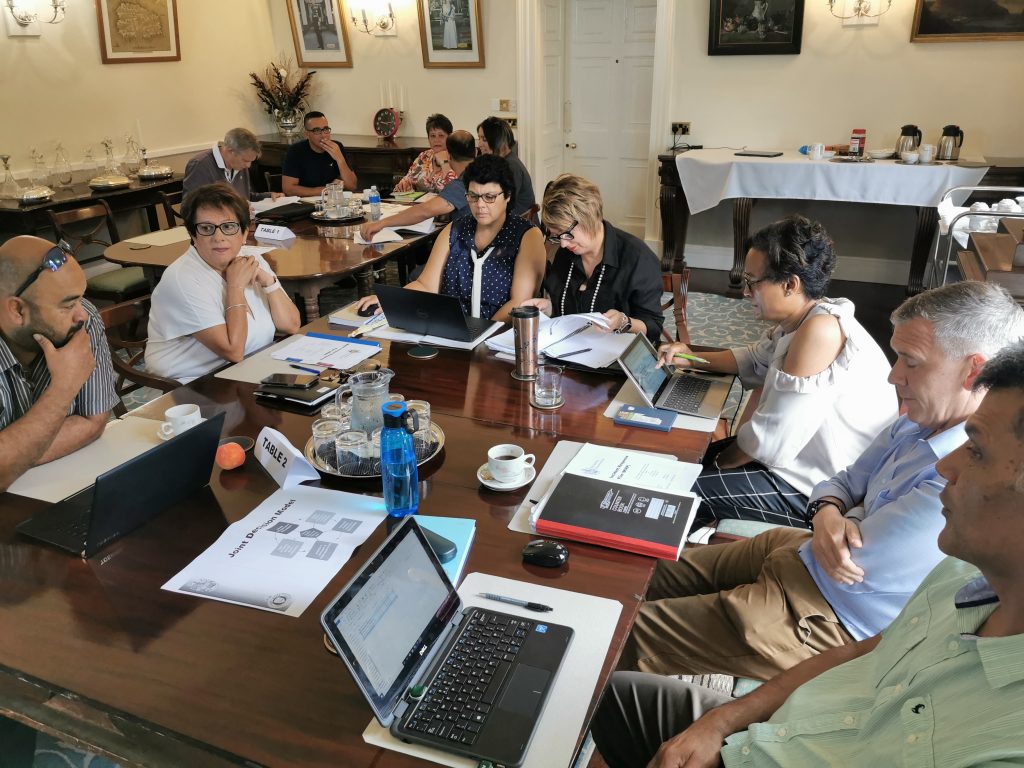3 February 2023
On Thursday 26 January, key officials and Ministers undertook a major incident response exercise at Plantation House. This was a table top exercise organised by the Emergency Planning section of the Safety, Security and Home Affairs Portfolio, and was designed to test the SHG Major Incident Response Plan, as well as those responsible for implementing it in a real life major incident scenario.
The Major Incident Response Plan forms part of the wider emergency planning and preparedness arrangements that SHG has in place. These try to anticipate and mitigate risk from major incidents, with the key aims of protecting life and property before restoring the community to a state of normality as soon as possible. The plan therefore considers a number of scenarios which might be reasonably considered to occur in St Helena, such as rockfalls or maritime and aeronautical search and rescue, as well as providing a framework for responders to use in any major incident.
Regular major Incident exercises are held to try to ensure the key parties involved in responding are able to effectively manage such an event as and when needed.
This particular exercise was named Blue Whale, and the scenario was that a cruise ship anchored in James Bay was experiencing a fire in the engine room. Attendees were tasked with responding to the incident as it developed, as well as then managing the Island’s return to normal after the initial incident had ended. The exercise involved those at the Gold and Silver Command levels, as well as the Incident Executive Group (IEG).
The Gold Command level are the people responsible for setting the strategic objectives and overall framework for the command structure, with those at the Silver Command level in charge of the tactical commanders responsible for managing the response based on the objectives set by the Gold Command. The IEG is made up of the Ministerial team and Governor’s Office, and their role is to provide scrutiny and endorsement of the strategic response set by the Gold Command level.
Commenting on the exercise, Head of Emergency Planning Simon Wade said:
“These exercises are important in not only making sure that the people involved in the strategic decision making in such events are well prepared to do so, but also to stress test our own plans and procedures more broadly. We constantly review our protocols and plans and undertake regular exercises. This helps to identify any gaps in the current plans ahead of them needing to be deployed in a real life situation, and means that decision makers and operational staff can confidently respond to major incidents when required.”
“This was a stretching exercise and we’re thankful to the Chief of Police, David Price, for delivering it on behalf of the Emergency Planning section and to the staff at Plantations House for accommodating us for the day.“
Chief Minister Julie Thomas said:
“This was an important exercise for the officials as well as for us as politicians. I was pleased to see how confident and competent the officials were in responding to the scenario. Although the Island tested much of the Major Incident Response Plan over the last few years in real life in the face of COVID-19, I was impressed with the way that those involved were able to quickly, effectively and comprehensively get on top of everything that was thrown at them. It was most certainly a testament to the need for collaborative working.”
Notes to Editor:
The Major Incident Response Plan has been developed on the principles of Integrated Emergency Management, those being: Anticipation, Assessment, Prevention, Preparation, Response and Recovery.
During a major incident the model for Command, Control and Coordination will broadly follow the UK principles of command and control i.e. Gold (Strategic), Silver (Tactical) and Bronze (Operational).
Whilst this particular exercise focused only on Gold and Silver Command levels, there is a further level below Silver Command which is Bronze Command. Those in this level are responsible for the delivering the operational response to the incident, based on the strategic objectives set by the Gold Command and the tactical objectives set by the Silver Command (see below image for more information).
The command structure ensures clarity so that all staff deployed knows:
- Who reports to whom
- Who is accountable for what
- Which individual / organisation is responsible for specific functions / tasks
It should be noted that the command structure is role and not rank specific.
SHG
1 February 2023
